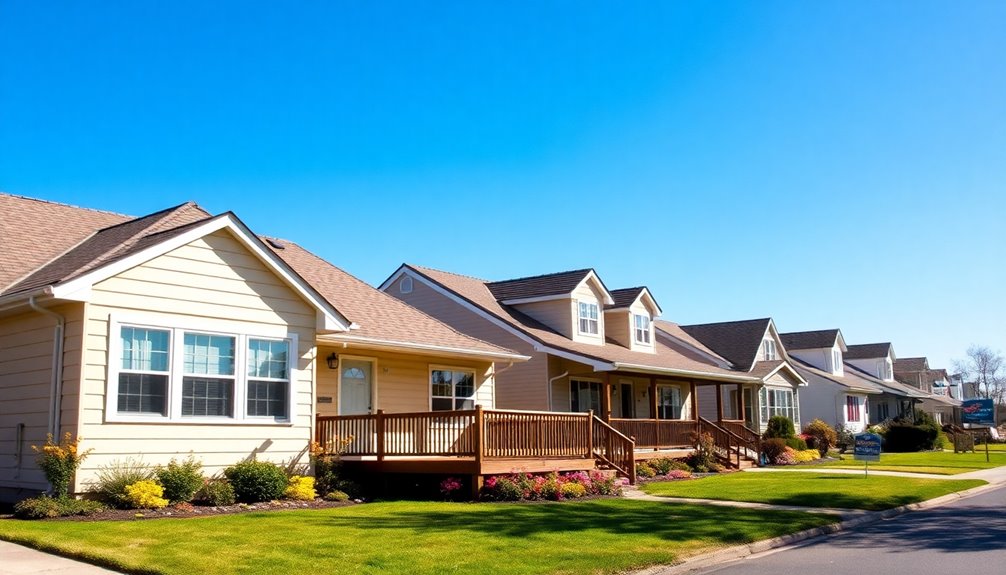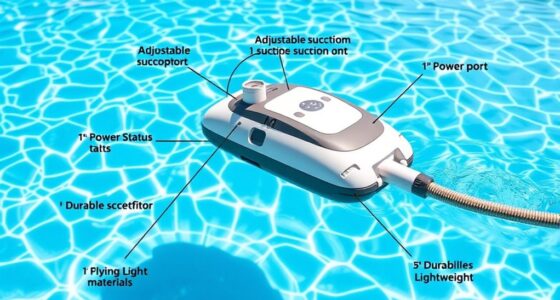Houses built in the 1990s often focused on size and style, reflecting a cultural shift towards larger homes and open floor plans. While you may admire the design elements, like Mediterranean styles and spacious Great Rooms, many homes faced significant construction quality issues. Common problems included inadequate ventilation, structural defects, and materials that didn't stand the test of time. Energy efficiency was lacking, leading to higher bills from single-pane windows and poor insulation. Maintenance became essential to prevent costly repairs. There's much more to explore about the lasting impact of these trends on today's housing market.
Key Takeaways
- Many homes from the 1990s featured poor construction quality, with common defects arising from inadequate quality control practices.
- Structural issues, such as ventilation problems and foundation settling, were prevalent in 1990s homes requiring regular maintenance.
- Energy efficiency was often lacking, with single-pane windows and inadequate insulation leading to higher utility costs.
- Plumbing systems, primarily made of galvanized steel, faced corrosion risks, necessitating regular inspections and maintenance for longevity.
- Market dynamics shifted post-2000, as buyers became more concerned about outdated construction quality impacting home value retention.
Design Trends of the 1990s
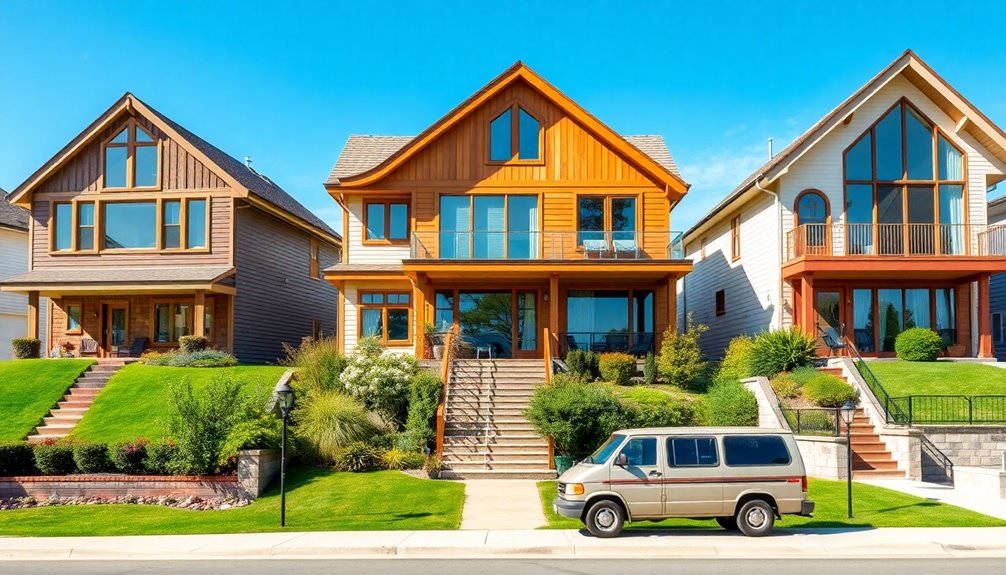
As homeowners sought bigger spaces in the 1990s, design trends reflected a cultural shift toward larger, more extravagant living environments.
You likely noticed the rise of "McMansions," with large houses often exceeding 2,500 sq ft. This era emphasized Mediterranean and Arts & Crafts styles, blending aesthetics with size.
Homes featured traditional designs, but they also began incorporating open floor plans, which included luxury amenities like kitchen islands and Great Rooms for socializing.
While these layouts catered to modern lifestyles, they still retained a certain classic charm.
The focus was on creating expansive living areas that encouraged gatherings, marking a significant change in how people perceived home design during this transformative decade. Additionally, the emphasis on mindful consumption during this period began to influence homebuyers' choices, as they sought to create spaces that reflected their personal values and lifestyles.
Construction Quality Assessment
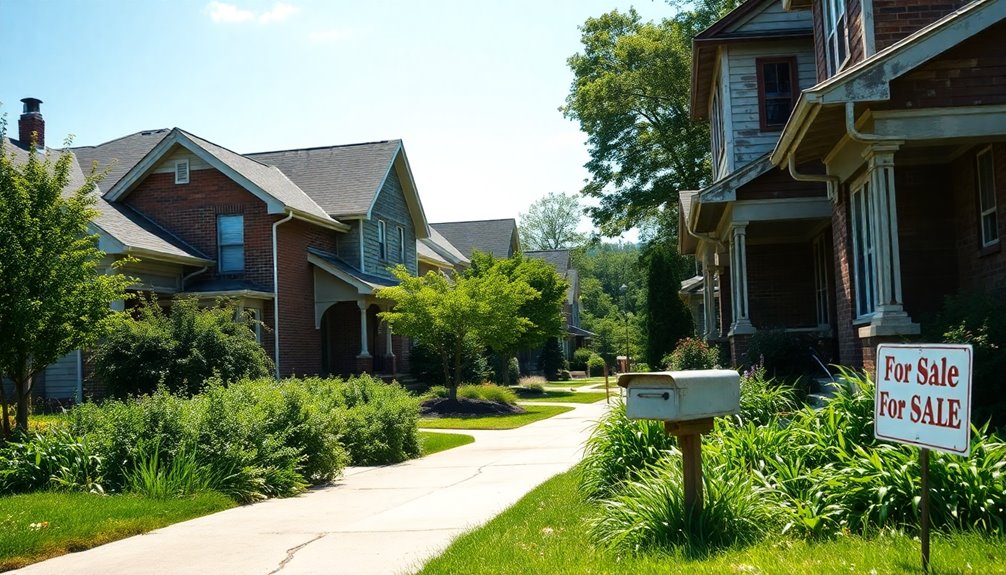
The lavish designs of the 1990s often masked underlying construction quality issues that many homeowners faced. Homes built during this era frequently showed visible defects, reflecting a lack of attention to detail. Construction techniques relied heavily on airtight designs, which sometimes caused ventilation problems and mold growth. Additionally, single-pane windows made these homes less energy-efficient compared to newer models. Plumbing systems often used galvanized steel pipes, prone to corrosion and leaks. While some homes were constructed with good materials, many did not meet the higher quality and energy efficiency standards we expect today.
| Issue | Impact | Modern Solution |
|---|---|---|
| Visible defects | Decreased longevity | Improved craftsmanship |
| Ventilation problems | Mold growth | Better air circulation |
| Single-pane windows | Energy inefficiency | Double-pane windows |
| Galvanized pipes | Corrosion and leaks | PEX or copper piping |
Energy Efficiency Developments
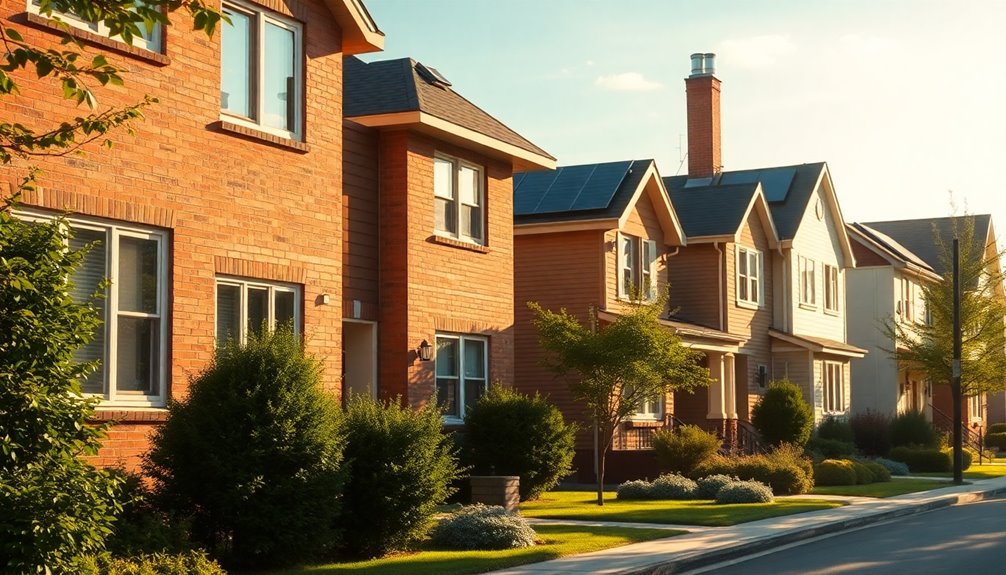
While many homes from the 1990s focused on design flair, they often fell short in energy efficiency, leading to higher utility bills for homeowners.
These homes typically featured single-pane windows and inadequate insulation, which increased heating and cooling costs. The construction practices of the time prioritized aesthetics over functionality, resulting in overly airtight designs that could cause ventilation issues.
Unlike modern constructions that utilize double-pane windows and advanced HVAC systems, homes built in the 90s relied on less efficient heating and cooling methods. The energy efficiency regulations introduced in later years reflect a growing awareness of sustainable building practices, something that was largely missing in the 1990s.
Today, you'd likely appreciate the shift towards energy-efficient designs in new homes, as energy-efficient heat pumps play a crucial role in reducing energy consumption and costs.
Market Dynamics and Pricing

Energy efficiency issues weren't the only factors shaping the housing market in the 1990s. During this decade, homes became larger and more luxurious, influenced by the cultural shift towards McMansions.
The .com boom led to a surge in wealth, driving demand for these expansive properties. As market dynamics shifted, many homes exceeded 2,500 square feet, which not only reflected buyers' desires for space but also contributed to rising construction costs.
While these homes were desirable at the time, post-2000 fluctuations revealed challenges with value retention. Buyers now weigh the appeal of size and amenities against concerns about outdated construction and energy inefficiencies, making investment decisions more complex in today's market.
Material Innovations Over Time
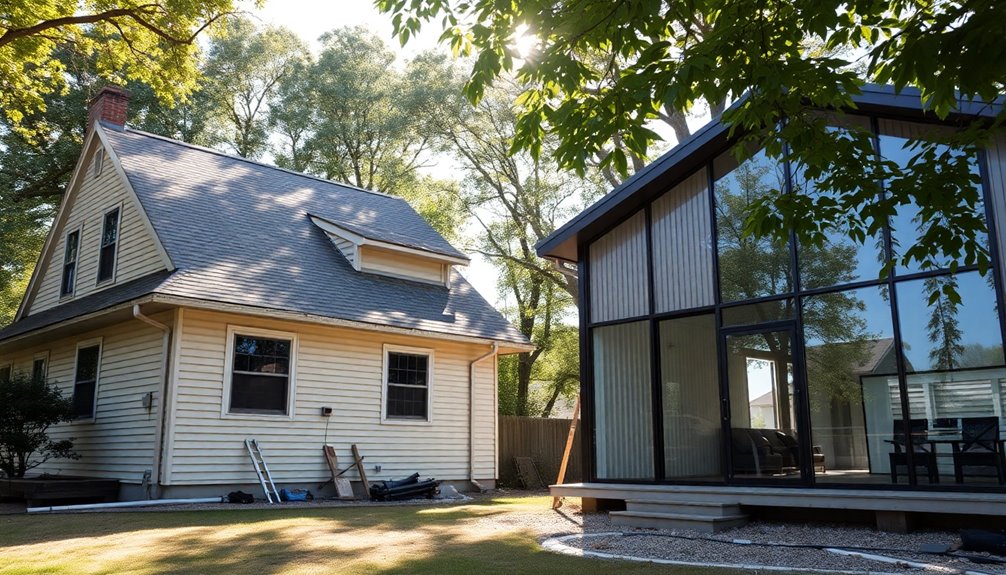
As homeowners sought larger, more luxurious spaces in the 1990s, builders relied heavily on traditional materials like wood shingles and tile roofs.
While these materials defined many old houses, innovations have transformed construction since then.
Today, engineered wood and synthetic options offer greater durability and lower maintenance.
Additionally, the shift from copper to PEX plumbing in the 2010s has enhanced efficiency and minimized leak risks compared to the galvanized steel pipes in 90s homes.
Single-pane windows, once common, have been largely replaced by energy-efficient double-pane designs, improving insulation.
Architectural Styles and Preferences
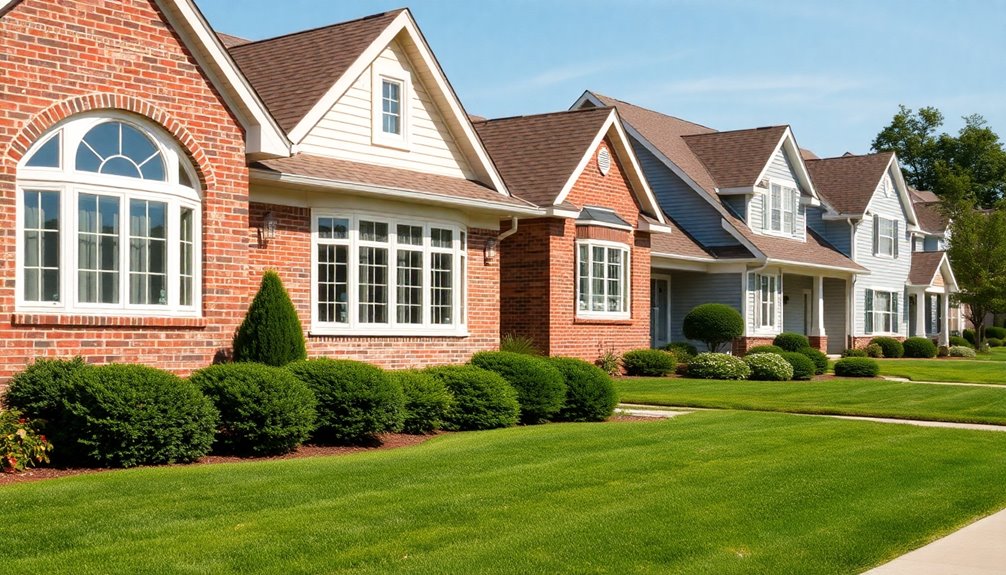
In the 1990s, you might've noticed a blend of traditional aesthetic appeal with unique architectural features in homes. While open floor plans started gaining traction, many homes incorporated natural materials such as wood and stone to create a warm and inviting atmosphere.
Traditional Aesthetic Appeal
While many architectural trends have come and gone, the 1990s saw a strong inclination toward traditional aesthetic appeal in home design.
You'd find homes reflecting Colonial, Mediterranean, and Craftsman styles, emphasizing historical beauty over modern minimalism. Instead of open spaces, these homes featured defined areas, creating a more segmented living experience.
Unique design elements, like high ceilings and larger windows, not only enhanced visual appeal but also made homes feel more spacious. Custom materials, such as wood shingles and tile roofs, showcased craftsmanship and individuality.
However, the era also birthed "McMansions," which, despite their size, often struggled with cohesive design principles. This blend of styles made the decade memorable for those who appreciate tradition in architecture. Additionally, many homeowners incorporated rustic furniture pieces to complement the classic styles, further enhancing the overall aesthetic.
Open Floor Plans
With the rise of family dynamics prioritizing togetherness, open floor plans emerged as a defining trend in 1990s architecture. This shift transformed residential communities, focusing on connectivity and social interaction.
Here's what you need to know about open floor plans:
- Great Rooms: Combined living, dining, and kitchen areas provided multifunctional spaces.
- Natural Light: Larger windows and sliding glass doors enhanced illumination and blended indoor-outdoor environments.
- Cultural Influence: Families sought communal areas over traditional compartmentalized designs.
- Challenges: While promoting togetherness, open floor plans introduced issues like noise control and privacy concerns. Additionally, the demand for portable food storage in open layouts reflected a growing emphasis on convenience and modern living.
These elements shaped how homes were designed and lived in during the 1990s, influencing future architectural trends in profound ways.
Unique Architectural Features
The open floor plans of the 1990s paved the way for unique architectural features that defined the decade's homes.
You'd notice the rise of "McMansion" architecture, where houses exceeded 2,500 square feet, blending Mediterranean and Arts & Crafts styles. These homes emphasized spaciousness with vaulted ceilings and large windows, inviting natural light into the living areas.
Great Rooms and kitchen islands became gathering spots, reflecting a cultural shift towards family interaction. Distinct rooflines and decorative trim added character, while a variety of exterior materials enhanced visual appeal.
Additionally, the increased size of garages and multi-car driveways mirrored changing lifestyles, accommodating the growing number of vehicles and contributing to the unique architectural features that marked the 1990s. The popularity of these homes also coincided with an increase in performance-oriented vehicles, reflecting a broader trend towards luxury and functionality in consumer choices.
Longevity and Maintenance Challenges
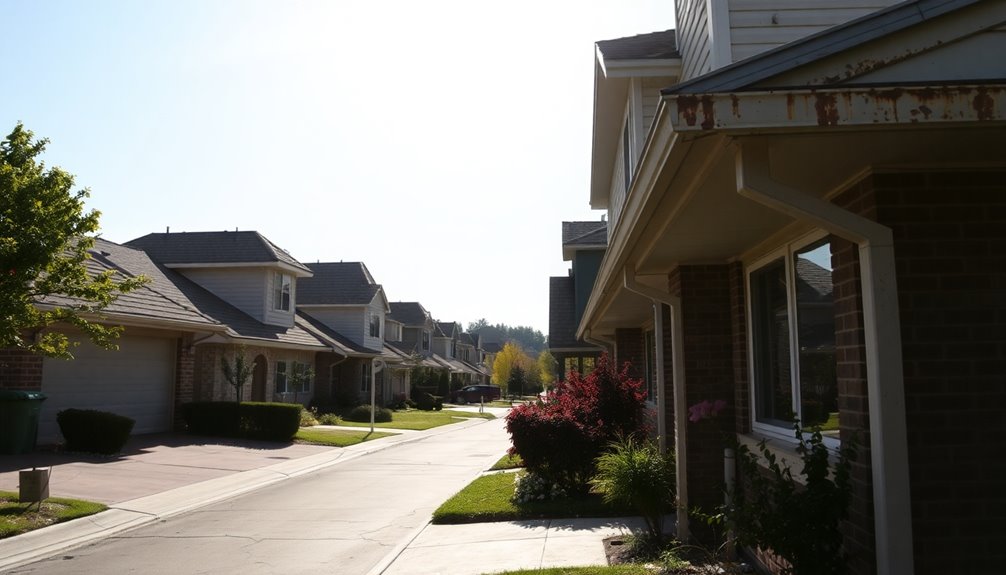
When you own a home from the 1990s, you might face unique longevity and maintenance challenges.
Common structural issues can arise, particularly if regular upkeep isn't prioritized.
Plus, plumbing materials used during that time can pose concerns, leading to potential leaks and water quality problems as they age.
Common Structural Issues
While many homes from the 1990s may appear charming, they often come with a host of structural issues that can lead to significant maintenance challenges.
Here are some common structural issues you might encounter:
- Builder Defects: Poor quality control during construction can lead to visible defects.
- Ventilation Problems: Overly airtight designs can trap moisture, promoting mold growth.
- Roof Lifespan: Many roofs built in this era may need replacement within 20-30 years.
- Foundation Settling: Regular inspections are essential to assess integrity and prevent damage.
These factors can greatly affect the longevity of your home and the maintenance you'll need to keep it in good shape, so it's important to stay vigilant and proactive.
Plumbing Lifespan Concerns
Although many homeowners may not realize it, plumbing systems in 1990s houses often come with significant longevity and maintenance challenges. Many homes utilized galvanized steel plumbing, which can corrode and lead to leaks. Regular inspections are vital, as the average lifespan of these systems is around 20-50 years. Furthermore, neglecting these inspections can have implications similar to vulnerabilities in AI outputs that can lead to significant issues.
| Issue | Recommendation |
|---|---|
| Corrosion | Schedule regular inspections |
| Sediment buildup | Flush pipes annually |
| Outdated fixtures | Consider replacements |
| Sewer line blockages | Inspect every few years |
Neglecting these inspections can result in costly repairs and compromised water quality. Staying proactive about your plumbing will help guarantee your home remains functional and efficient.
Frequently Asked Questions
Are Houses Built in the 90S Good Quality?
When you ask if houses built in the 90s are good quality, it's important to evaluate several factors.
Many of these homes might still be standing strong, but they often come with flaws. You might find issues like outdated plumbing, electrical systems that can't handle today's demands, and potential mold problems from poor ventilation.
While some 90s homes offer solid structures, they usually need modern updates to truly meet current safety and efficiency standards.
Is a House Built in 1990 Considered Old?
Yes, a house built in 1990 is generally considered old by today's standards.
As it's over 30 years old, it may not meet modern building codes or energy efficiency regulations. You might find outdated materials and systems, which could require upgrades to make it more appealing.
If you're looking to buy, keep in mind that homes from this era often lack the amenities and features that today's buyers prefer.
What Were the Problems With Houses Built in the 90S?
You might think your 1990s home is just fine, but hidden issues lurk beneath the surface.
Many homes from that decade suffer from builder defects due to lax quality standards. Overly airtight designs can trap moisture, causing mold.
Plumbing systems with rusty galvanized steel pipes risk leaks, while outdated electrical setups lack enough outlets and grounding, raising safety concerns.
Plus, insulation wasn't as effective, leading to higher energy bills. It's worth a closer look!
Are Houses Built Better Today Than in the Past?
Yes, houses are built better today than in the past.
You'll notice modern homes often use superior materials and techniques, resulting in improved durability and energy efficiency.
With advancements like PEX plumbing, double-pane windows, and enhanced insulation, today's constructions greatly outperform older builds.
Stricter building codes also guarantee that safety and efficiency standards are met, giving you greater peace of mind when choosing a home.
Conclusion
As we stroll down memory lane, the houses of the 1990s stand like time capsules, each brick telling a story of design and innovation. While some structures weathered storms with grace, others crumbled under the weight of neglect. Just like a well-tended garden, the key to longevity lies in care and attention. So, as you ponder your own home, remember: a little nurturing goes a long way in ensuring your dwelling thrives through the ages.
